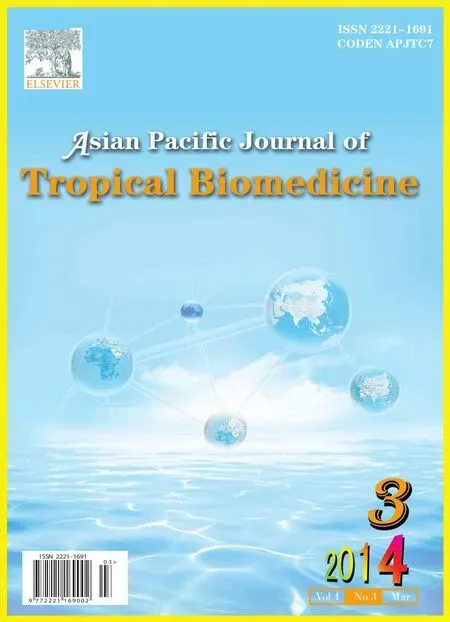Katayama syndrome in patients with schistosomiasis
Shailendra Kapoor
74 Polk avenue, Chicago, IL, USA
Katayama syndrome in patients with schistosomiasis
Shailendra Kapoor
74 Polk avenue, Chicago, IL, USA
To the editor,
I read with great interest the recent article by Erkoet al[1]. Interestingly, one facet of schistosomal infection that is often overlooked is Katayama syndrome (KS).
The constellation of symptoms seen in KS is secondary to eosinophil mediated systemic vasculitis. Small vessel thrombosis may accompany the vasculitis. This eosinophilic response is triggered by the migrating schistosomula[2]. KS overall represents a hyper-sensitivity response. Symptoms and signs usually appear within six weeks of onset of the schistosomal infection. Symptoms have been reported as much as 12 weeks following initial infestation. A history of contact with water bodies can be elicited in most patients with KS. In rare cases, the symptoms may appear as early as three weeks after initial exposure. KS may rarely occur in outbreaks as recently report by Zuidema[3]. Similar mini-epidemics have been reported by Loutanet al[4].
Disease onset is usually acute. Nocturnal fever is a characteristic of the syndrome and is seen in 60% of the patients[5]. Patients may also complain of sputum free cough and significant malaise. Vomiting and diarrhea are also usually present. Urticaria may be present at the same time. Physical examination may reveal marked abdominal tenderness as well as hepatic enlargement. In general, symptoms and signs involving the respiratory tract tend to occur in the initial phase of the syndrome while abdominal signs and symptoms tend to occur much later during the course of the syndrome. Neurological manifestations are typically seen during the early phase of KS[6]. The most common neurological syndrome that is encountered is transverse myelitis.
Anti-schistosomal antibodies are usually positive in KS and help in making an early diagnosis of the syndrome. Serological tests have an overall sensitivity of 95.5% in detecting schistosomiasis[7]. Egg detection is also another way of confirming the diagnosis. Peripheral blood examination reveals significant eosinophilia in 91% of the patients. Eosinophilic counts as high as 3 080 cells/mm3have been reported[8]. Chest X rays may reveal diffuse infiltrates within the lung fields. Rochaet al.have also reported micro-nodules in the inferior lung fields in patients with KS. These nodules usually have a beaded appearance.
Praziquantel should be initiated immediately during the acute phase of KS. A daily dose of 40 mg/kg needs to be administered for at least three days. Xiaoet al.have recently reported success with artemether also[9]. Oxamniquine is another emerging alternative that has shown considerable promise. Concurrent steroid therapy is in general recommended for the management of KS. Most patients become asymptomatic after a mean period of 4.8 d[3]. The constellation of symptoms encompassing KS may recur despite adequate initial treatment in 22% of the patients[6].
Early initiation of adequate therapy greatly mitigates the progression of KS. KS should be especially watched for in tourists returning from areas endemic for schistosomiasis.
Conflict of interest statement
We declare that we have no conflict of interest.
[1] Erko B, Degarege A, Tadesse K, Mathiwos A, Legesse M. Efficacy and side effects of praziquantel in the treatment of schistosomiasis mansoni in schoolchildren in Shesha Kekele elementary school, Wondo Genet, Southern Ethiopia. Asian Pac J Trop Biomed 2012; 2(3): 235-239.
[2] Jaureguiberry S, Caumes E. Neurological involvement during Katayama syndrome. Lancet Infect Dis 2008; 8(1): 9-10.
[3] Zuidema PJ. The Katayama syndrome; an outbreak in Dutch tourists to the Omo National Park, Ethiopia. Trop Geogr Med 1981; 33(1): 30-35.
[4] Loutan L, Farinelli T, Robert CF. [Acute schistosomiasis or Katayama syndrome: apropos of 2 mini-epidemics]. Schweiz Med Wochenschr 1996; 126(35): 1482-1486. French.
[5] Ross AG, Vickers D, Olds GR, Shah SM, McManus DP. Katayama syndrome. Lancet Infect Dis 2007; 7(3): 218-224.
[6] Clerinx J, van Gompel A, Lynen L, Ceulemans B. Early neuroschistosomiasis complicating Katayama syndrome. Emerg Infect Dis 2006; 12(9): 1465-1466.
[7] Yasawy MI. Katayama syndrome. Saudi Med J 2004; 25: 234-236.
[8] Mohamed AE. The Katayama syndrome in Saudis. J Trop Med Hyg 1985; 88(5): 319-322.
[9] Centers for Disease Control (CDC). Cercarial dermatitis among bathers in California; Katayama syndrome among travelers to Ethiopia. MMWR Morb Mortal Wkly Rep 1982; 31(32): 435-438.
10.1016/S2221-1691(14)60239-2
*Corresponding author: Shailendra Kapoor MD, 74 Polk avenue, Chicago, IL, USA.
Tel: 8655675678
E-mail: shailendrakapoor@yahoo.com
Article history:
Received 30 Dec 2013
Received in revised form 3 Jan, 2nd revised form 10 Jan, 3rd revised form 16 Jan 2014
Accepted 18 Feb 2014
Available online 28 Mar 2014
 Asian Pacific Journal of Tropical Biomedicine2014年3期
Asian Pacific Journal of Tropical Biomedicine2014年3期
- Asian Pacific Journal of Tropical Biomedicine的其它文章
- An update on Ayurvedic herb Convolvulus pluricaulis Choisy
- Evidence of increasing L1014F kdr mutation frequency in Anopheles gambiae s.l. pyrethroid resistant following a nationwide distribution of LLINs by the Beninese National Malaria Control Programme
- Prevalence and antimicrobial resistance of Salmonella spp. in raw retail frozen imported freshwater fish to Eastern Province of Saudi Arabia
- Hesperidin as a preventive resistance agent in MCF-7 breast cancer cells line resistance to doxorubicin
- Anti-oxidative and anti-inflammatory effects of Tagetes minuta essential oil in activated macrophages
- Long-term spatial memory and morphological changes in hippocampus of Wistar rats exposed to smoke from Carica papaya leaves
